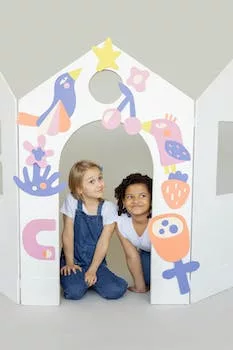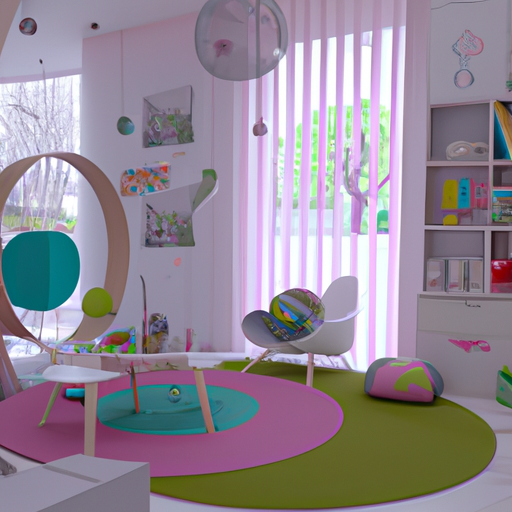Designing Safe and Engaging Play Spaces for Children at Home
The importance of design in creating a home that’s perfect for children cannot be overstated. A well-designed home not only provides a safe and nurturing environment for children to grow and develop, but it also fosters their creativity, curiosity, and sense of belonging. Designing safe and engaging play spaces for children at home is a crucial aspect of this process, as it allows them to explore their interests, develop their skills, and form lasting memories with their family and friends.
One of the primary considerations when designing a child-friendly home is safety. Children are naturally curious and adventurous, which can sometimes lead to accidents and injuries. Therefore, it is essential to create spaces that minimize potential hazards while still allowing children to play and learn freely. This can be achieved by selecting age-appropriate furniture and play equipment, using non-toxic materials and finishes, and incorporating safety features such as rounded corners, slip-resistant flooring, and secure storage for toys and other belongings.
In addition to safety, it is important to consider the overall layout and organization of the home. Children thrive in environments that are both functional and visually appealing, as these spaces encourage them to engage with their surroundings and develop a sense of autonomy. This can be achieved by creating designated play areas that are easily accessible and visible from other parts of the home, allowing parents to supervise their children while still giving them the freedom to explore and play independently. Furthermore, incorporating ample storage solutions for toys, books, and other belongings can help to maintain a clutter-free environment, which is not only more aesthetically pleasing but also promotes better focus and concentration for children.
Another key aspect of designing a child-friendly home is the selection of colors, patterns, and textures. Research has shown that children are highly sensitive to their visual environment, and the colors and patterns they are exposed to can have a significant impact on their mood, behavior, and cognitive development. Therefore, it is important to choose colors and patterns that are both visually stimulating and calming, such as soft pastels, warm neutrals, and nature-inspired hues. Additionally, incorporating a variety of textures through fabrics, rugs, and other furnishings can help to create a more tactile and sensory-rich environment, which is particularly beneficial for young children who are still developing their fine motor skills and spatial awareness.
Creating engaging play spaces for children at home also involves selecting the right toys and play equipment. It is important to choose items that are not only age-appropriate and safe but also promote creativity, problem-solving, and social interaction. This can include a mix of open-ended toys, such as building blocks, art supplies, and dress-up clothes, as well as more structured activities, such as board games, puzzles, and educational software. Additionally, incorporating elements of nature and the outdoors, such as plants, natural materials, and access to outdoor play spaces, can help to foster a deeper connection with the environment and promote overall well-being.
In conclusion, designing a home that is perfect for children involves a careful balance of safety, functionality, and aesthetics. By creating safe and engaging play spaces, parents can provide their children with the opportunity to explore their interests, develop their skills, and form lasting memories in a nurturing and supportive environment. Furthermore, a well-designed home can help to foster a sense of belonging and identity for children, which is essential for their emotional and social development. Ultimately, the importance of design in creating a home that’s perfect for children cannot be overstated, as it lays the foundation for a lifetime of growth, learning, and happiness.
The Role of Color Psychology in Creating a Child-Friendly Home Environment

The importance of design in creating a home that’s perfect for children cannot be overstated. A well-designed home not only provides a safe and comfortable environment for children to grow and thrive, but it also fosters their creativity, imagination, and overall well-being. One crucial aspect of designing a child-friendly home is understanding the role of color psychology in creating a nurturing and stimulating environment.
Color psychology is the study of how colors affect human behavior, emotions, and mental processes. It is a fascinating field that has gained increasing attention in recent years, as researchers and designers alike have come to appreciate the powerful impact that colors can have on our lives. In the context of designing a home for children, color psychology can be a valuable tool for creating spaces that are both visually appealing and conducive to healthy development.
One of the most important considerations when selecting colors for a child’s living environment is the age of the child. Different colors have different effects on children of various ages, and it is essential to choose colors that are appropriate for the child’s developmental stage. For example, infants and toddlers are particularly sensitive to bright, bold colors, which can be overstimulating and even distressing for them. In contrast, older children and adolescents may respond more positively to vibrant hues, as they can help to energize and inspire them.
Another key factor to consider when choosing colors for a child’s living space is the intended function of the room. Different colors can evoke different emotions and psychological responses, and it is essential to select colors that support the desired atmosphere and activities in each space. For instance, calming colors such as soft blues, greens, and neutrals are ideal for bedrooms and other areas where relaxation and rest are the primary goals. On the other hand, more energetic colors like bright yellows, oranges, and reds can be used in playrooms and other spaces where children are encouraged to be active and creative.
It is also important to consider the individual preferences and personalities of the children who will be living in the home. While color psychology can provide valuable insights into the general effects of different colors on children, it is essential to remember that each child is unique, and their reactions to specific colors may vary. For this reason, it can be helpful to involve children in the process of selecting colors for their living spaces, as this can help to ensure that the chosen colors resonate with them on a personal level.
In addition to selecting the right colors for a child’s living environment, it is also crucial to consider the overall design and layout of the space. A well-designed home should provide ample opportunities for children to explore, play, and learn, while also offering quiet, comfortable spaces for rest and relaxation. This can be achieved through thoughtful space planning, the use of functional and adaptable furniture, and the incorporation of engaging and educational elements such as artwork, books, and toys.
In conclusion, the role of color psychology in creating a child-friendly home environment is an essential aspect of designing a home that is perfect for children. By understanding the impact of different colors on children’s emotions, behavior, and development, parents and designers can create spaces that are not only visually appealing but also supportive of children’s well-being and growth. By carefully considering the age, preferences, and personalities of the children who will be living in the home, as well as the intended function of each space, it is possible to create a home environment that truly nurtures and inspires the next generation.
Incorporating Educational Elements into Your Home Design for Children’s Development
The importance of design in creating a home that’s perfect for children cannot be overstated. A well-designed home not only provides a safe and comfortable environment for children to grow up in, but it can also play a crucial role in their overall development. By incorporating educational elements into your home design, you can create a space that fosters learning, creativity, and curiosity, setting the stage for a lifetime of success.
One of the most effective ways to incorporate educational elements into your home design is by creating designated spaces for learning and exploration. This can be as simple as setting up a reading nook in the living room or as elaborate as designing a dedicated playroom filled with educational toys and materials. By providing a space where children can engage in focused, independent learning, you are encouraging them to develop essential skills such as problem-solving, critical thinking, and self-motivation.
Another important aspect of designing a home that’s perfect for children is ensuring that the environment is rich in sensory experiences. Children learn best when they are able to explore and interact with their surroundings using all of their senses. This means incorporating a variety of textures, colors, and materials into your home design, as well as providing opportunities for children to engage in hands-on activities such as cooking, gardening, and art projects. By creating a sensory-rich environment, you are helping to stimulate your child’s brain development and fostering a love of learning.
In addition to creating designated spaces for learning and exploration, it’s also important to consider the layout and organization of your home. A well-organized home can help to promote a sense of order and routine, which is essential for children’s development. By creating designated spaces for specific activities, such as a homework station or a craft area, you are helping to establish clear expectations and boundaries for your children. This not only helps to reduce distractions and promote focus, but it also teaches children the importance of responsibility and time management.
When designing a home that’s perfect for children, it’s also important to consider the role of technology. While technology can certainly be a valuable educational tool, it’s essential to strike a balance between screen time and other forms of learning and play. By incorporating technology into your home design in a thoughtful and intentional way, you can help to ensure that your children are using it as a tool for learning and growth, rather than as a means of passive entertainment.
Finally, it’s important to remember that the most effective educational environments are those that are flexible and adaptable. As your children grow and their interests and needs change, your home should be able to evolve with them. This means choosing furniture and design elements that can be easily reconfigured or repurposed, as well as being open to making changes and updates as needed. By creating a home that can grow and change with your children, you are setting the stage for a lifetime of learning and development.
In conclusion, the importance of design in creating a home that’s perfect for children cannot be overstated. By incorporating educational elements into your home design, you can create a space that fosters learning, creativity, and curiosity, setting the stage for a lifetime of success. By creating designated spaces for learning and exploration, providing a sensory-rich environment, ensuring a well-organized layout, incorporating technology in a thoughtful way, and designing a flexible and adaptable space, you can create a home that truly supports your children’s development and sets them up for a bright future.
Q&A
Question 1: Why is design important in creating a home that’s perfect for children?
Answer 1: Design is important in creating a home that’s perfect for children because it ensures safety, promotes healthy development, and fosters creativity and learning. A well-designed home considers the needs of children, such as age-appropriate spaces, easy-to-clean surfaces, and ample storage for toys and belongings.
Question 2: How can design elements help in the cognitive development of children?
Answer 2: Design elements can help in the cognitive development of children by providing stimulating and engaging environments. This can be achieved through the use of colors, textures, and patterns that encourage curiosity and exploration, as well as creating dedicated spaces for play, learning, and relaxation.
Question 3: What are some key design considerations when creating a child-friendly home?
Answer 3: Some key design considerations when creating a child-friendly home include ensuring safety by using childproofing measures, creating age-appropriate spaces that cater to the child’s needs and interests, providing ample storage for toys and belongings, using easy-to-clean and durable materials, and incorporating elements that promote learning, creativity, and social interaction.
Conclusion
In conclusion, the importance of design in creating a home that’s perfect for children cannot be overstated. A well-designed home promotes safety, fosters creativity, encourages learning, and supports the overall well-being of children, ultimately contributing to their healthy growth and development. By incorporating child-friendly design elements, parents can create a nurturing and engaging environment that meets the unique needs of their children and sets the foundation for a happy and fulfilling childhood.


